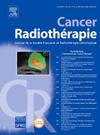所有T1N0非小细胞肺癌患者手术治疗?
IF 1.4
4区 医学
Q4 ONCOLOGY
引用次数: 0
摘要
T1N0非小细胞肺癌约占所有肺癌病例的20%,定义为肿瘤达3cm,无淋巴结或远处转移。早期诊断的发生率正在增加,主要是由于低剂量计算机断层扫描筛查程序的实施。长期以来,手术一直被认为是治疗这些肿瘤的标准方法,它提供了良好的肿瘤预后,并允许进行必要的病理分期。然而,在某些人群中,特别是老年人或医学上不能手术的患者,手术可能是指征或难以耐受的。立体定向放射治疗已成为一种非侵入性的替代方法,具有较高的局部控制率和降低早期发病率。这就提出了一个关键的问题:所有早期非小细胞肺癌患者都应该进行手术治疗,还是应该进行个体化治疗?目前的证据强调需要平衡治疗意图与治疗相关的风险。目前有几个临床试验正在评估可手术患者的立体定向体放疗,旨在确定可能从非手术方法中获益的亚群。本综述提倡个性化、以患者为中心的治疗策略,整合肿瘤特征、可操作性、合并症和患者偏好。本文章由计算机程序翻译,如有差异,请以英文原文为准。
Surgery for all patients with T1N0 non-small cell lung cancer?
T1N0 non-small cell lung cancers account for about 20 % of all lung cancer cases and are defined as tumours up to 3 cm without nodal or distant metastasis. The incidence of early-stage diagnoses is increasing, largely driven by the implementation of low dose computed tomography screening programs. Surgery has long been considered the standard of care for these tumours, offering excellent oncologic outcomes and allowing essential pathological staging. However, surgery may be indicated or poorly tolerated in certain populations, particularly elderly or medically inoperable patients. Stereotactic body radiotherapy has emerged as a non-invasive alternative with high local control rates and reduced early morbidity. This raises a critical question: should all patients with early-stage non-small cell lung cancer be managed surgically, or is there a role for treatment individualization? Current evidence highlights the need of balancing curative intent with treatment-related risks. Several clinical trials are currently evaluating stereotactic body radiotherapy in operable patients, aiming to identify subsets that may derive benefit from a non-surgical approach. This review advocates for a personalized, patient-centred treatment strategy, integrating tumour characteristics, operability, comorbidities, and patient preference.
求助全文
通过发布文献求助,成功后即可免费获取论文全文。
去求助
来源期刊

Cancer Radiotherapie
医学-核医学
CiteScore
2.20
自引率
23.10%
发文量
129
审稿时长
63 days
期刊介绍:
Cancer/radiothérapie se veut d''abord et avant tout un organe francophone de publication des travaux de recherche en radiothérapie. La revue a pour objectif de diffuser les informations majeures sur les travaux de recherche en cancérologie et tout ce qui touche de près ou de loin au traitement du cancer par les radiations : technologie, radiophysique, radiobiologie et radiothérapie clinique.
 求助内容:
求助内容: 应助结果提醒方式:
应助结果提醒方式:


